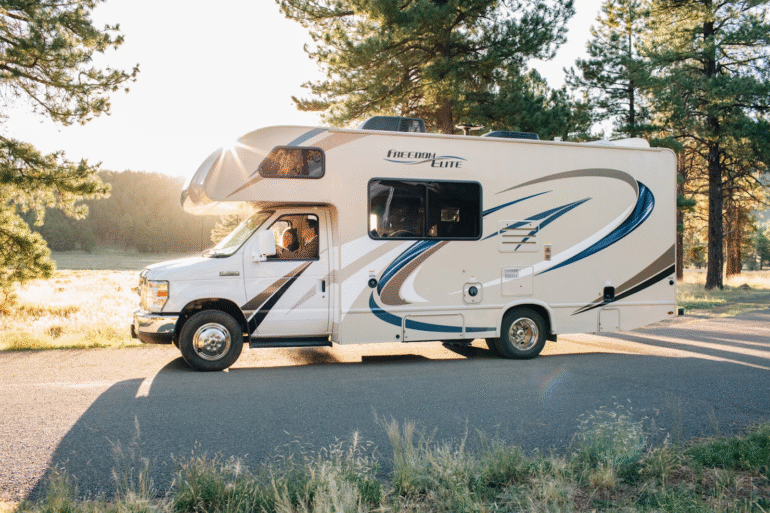When last did you hit the road and visit more of the places around you? No deadlines. No schedules. No pressure. Just the freedom to wander. Northern California was made for exactly that.
But there’s a lot of space to explore. So where would you even start? This guide is here to help.
Planning your RV road trip
Got a short trip planned? Or maybe a month-long journey across the state? Either way, there are a few things you need to get in order before you leave.
First off, you have to know that some Northern California roads aren’t for the faint of heart. Especially when you’re exploring the more unusual paths.
Expect winding turns and steep climbs. As well as a couple of spots that will make you doubt any other vehicle can go past you. So if you’re new to RV life, a small-to-mid-sized motorhome will make things easier.
Big rigs can manage in some spots. But those narrow coastal roads and tiny town streets? They’ll keep you on your toes.
For a local San Francisco campervan rental option, get hold of Indie Campers. Their modern vans are easy to drive. And they offer one-way trips, which is a big plus if you’re not circling back to San Francisco.
Other solid choices include:
- Cruise America for larger RVs and longer rentals.
- Roadsurfer for shorter, flexible trips that focus on comfort.
Pick your season
Before you book your time off, check the calendar! Spring and fall bring the most pleasant times to adventure through Northern California. You get mild weather and small crowds. And the roads are usually pretty clear.
The rest of the year can be great too. Summer has long days and plenty of energy. But because it’s so nice out, traffic can get heavy. And wildfires can cause dangerous conditions. Winter is beautiful in its own way. But you have to watch the mountain passes for closures and any icy spots.
Tip: Heading to the redwoods or Lake Tahoe? Book your campsites early because they fill fast. You can use ReserveCalifornia or Recreation.gov.
Stay prepared while on the road
Cell signal disappears quickly once you’re out of the city. Grab your maps ahead of time. Maybe toss a paper one in the glovebox. And get into the habit of checking your route each morning.
A few apps worth having on your phone:
- Roadtrippers for plotting detours and finding quirky roadside stops.
- Campendium has real campground reviews from other RVers.
- GasBuddy, so you don’t end up running on fumes between tiny towns.
Pro tip: Stock up on groceries before you roll out of San Francisco. Once you’re north of the city, fresh produce and big supermarkets can get scarce fast.
Scenic RV routes from San Francisco
Once you’ve found your RV rental and hit the highway, the coast north of San Francisco unfolds beautifully.
Cool coastal escapes
San Francisco -> Point Reyes -> Sonoma Coast -> Mendocino

Leave the city and follow the coast to Point Reyes. The Golden Gate disappears behind you. The air smells salty. Watch for tule elk on the hills. On the beach, the elephant seals just lie there.
You won’t find RV sites inside the park, but Olema Campground is close enough. And you’ll hear the ocean at night.
Then comes Highway 1. Narrow, winding, sometimes a little tense. But the views make you forget all that. Stop at Goat Rock Beach if you can. Maybe grab lunch in Jenner, the seafood’s good, and stay until the sun drops.
Keep going north to Mendocino. The cliffs rise, the town appears, quiet and a bit timeless. RV spots in Fort Bragg or Caspar work fine. Walk along Glass Beach, or check out the trails at Russian Gulch. You could also just sit by the water and let the waves wash over you.
Wine country on wheels
San Francisco -> Sonoma Valley -> Napa Valley -> Russian River -> Alexander Valley
If you’re into wine and rolling hills, head northeast to Sonoma Valley. You’ll quickly see why. The drive is stunning. Vineyards run along both sides. Every few miles, there’s a small tasting room hidden among the trees.
Call ahead to the smaller spots. Parking can be tight, but they usually treat you like old friends once you’re there. Fall is busy and full of gold light. In spring, the roads are quiet and wildflowers grow everywhere.
Continue until you reach Napa Valley, where some RV parks offer shuttles to the wineries, making transportation simpler. Then, follow the road toward the Russian River. Along the way, you’ll likely discover several inviting stops. The landscape here is shady and calm, with relaxed wineries and leisurely lunches that can stretch through the afternoon.
End your loop in Alexander Valley. The crowds are smaller and the roads are slower. Most of the vineyards are run by families. Somehow, you end up wanting to stay another night.
Among the redwoods
San Francisco -> Avenue of the Giants -> Prairie Creek
Ever stood under a tree older than most countries? You can do that here.
Head north to the Avenue of the Giants. The road twists through Humboldt Redwoods State Park. Trees tower over everything. You will pass rivers, tiny creeks, and old wooden bridges that look like they belong in a movie.
Driving is easy enough. Stop at Burlington or Hidden Springs if you need a break. Walk the trails. Look at the ferns. Lie down for a bit and listen to the wind in the leaves. Sometimes the smell of damp earth and pine comes all at once.
Prairie Creek Redwoods near Orick. Trails are easy. Campgrounds quiet. You might see Roosevelt elk wandering nearby. The forest makes you pause and take it in.
Mountains, lakes, and wide open skies
San Francisco -> Mount Shasta -> Shasta-Trinity National Forest -> Lake Tahoe

Go inland and everything changes. The air sharpens. The trees stretch higher, the light turns clearer.
After a few hours, you’ll reach Shasta Lake. Step out, walk a bit, take it in. There’s a quiet trail by the water if you feel like moving, or you can just sit and watch the boats drift. Mount Shasta stands far off, snow still clinging to the top, clouds rolling slow across it.
Keep driving east to Lassen Volcanic. The ground feels alive here. Steam seeps from cracks, and the air carries that faint metallic tang from deep below. Try to camp near Manzanita Lake if there’s space. It’s close to the trails, and the quiet at night settles deep.
Then head north toward Prairie Creek Redwoods. The trails wind through ferns and those massive old trees that block out half the light. You might catch sight of elk out in the open.
Finish your run at Lake Tahoe. The place has a way of slowing you down. Hike Eagle Rock, follow the Rubicon Trail, or get on the water. If you’re parked close by, wake up early and walk the shoreline while it’s still half-dark. The air’s cold, clean, and completely still.
Hidden gems worth the detour
San Francisco -> Lost Coast -> Lassen Volcanic National Park -> Gold Country
If you’ve got time, take the slower road. It’s tougher to drive, but worth every turn.
Follow Mattole Road to the Lost Coast. It twists and narrows through hills and fog, best handled in a smaller van. The payoff is the silence. It’s just you, the cliffs, and the sound of waves hitting rock. You can camp near Black Sands Beach or wander into Sinkyone Wilderness for a while.
From there, drift east toward Lassen again. Pine forests, hot springs, open sky. Nights get dark here, stars bright enough to feel close.
Wrap up in Gold Country along Highway 49. Nevada City and Grass Valley still carry that old-town feel with wooden storefronts and slow rivers. Not to mention the people who still greet strangers and extend a welcoming smile.
Northern California roads are the ultimate RV playground
You can do these routes one at a time. Or try to squeeze them all into one big adventure. Weekend van trip, retirement escape, maybe even a honeymoon on wheels. Any of it works.
The coast, the mountains, the redwoods, the vineyards. Honestly, everywhere you turn, there’s something worth stopping for. Stop when it feels right. Take longer at a beach. Grab an extra glass of wine. Sleep under the stars. That’s the fun of an RV road trip. Pack up, hit the road, and see where it takes you.
What say you?
Thoughts on these RV Adventures in Northern California?
Let’s hear it!








